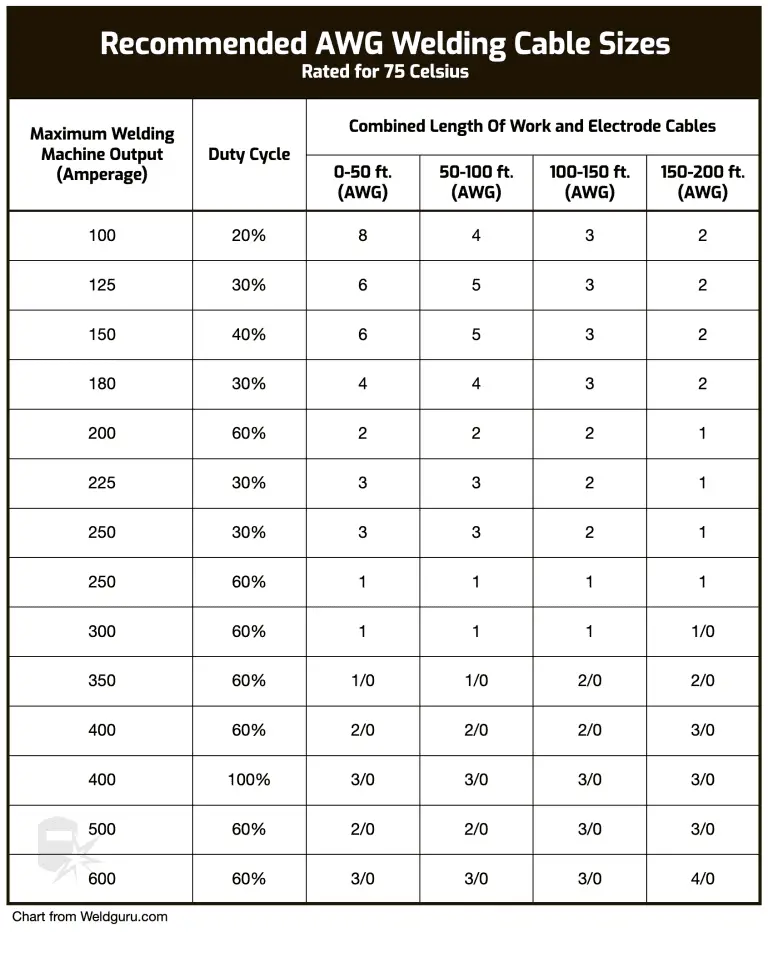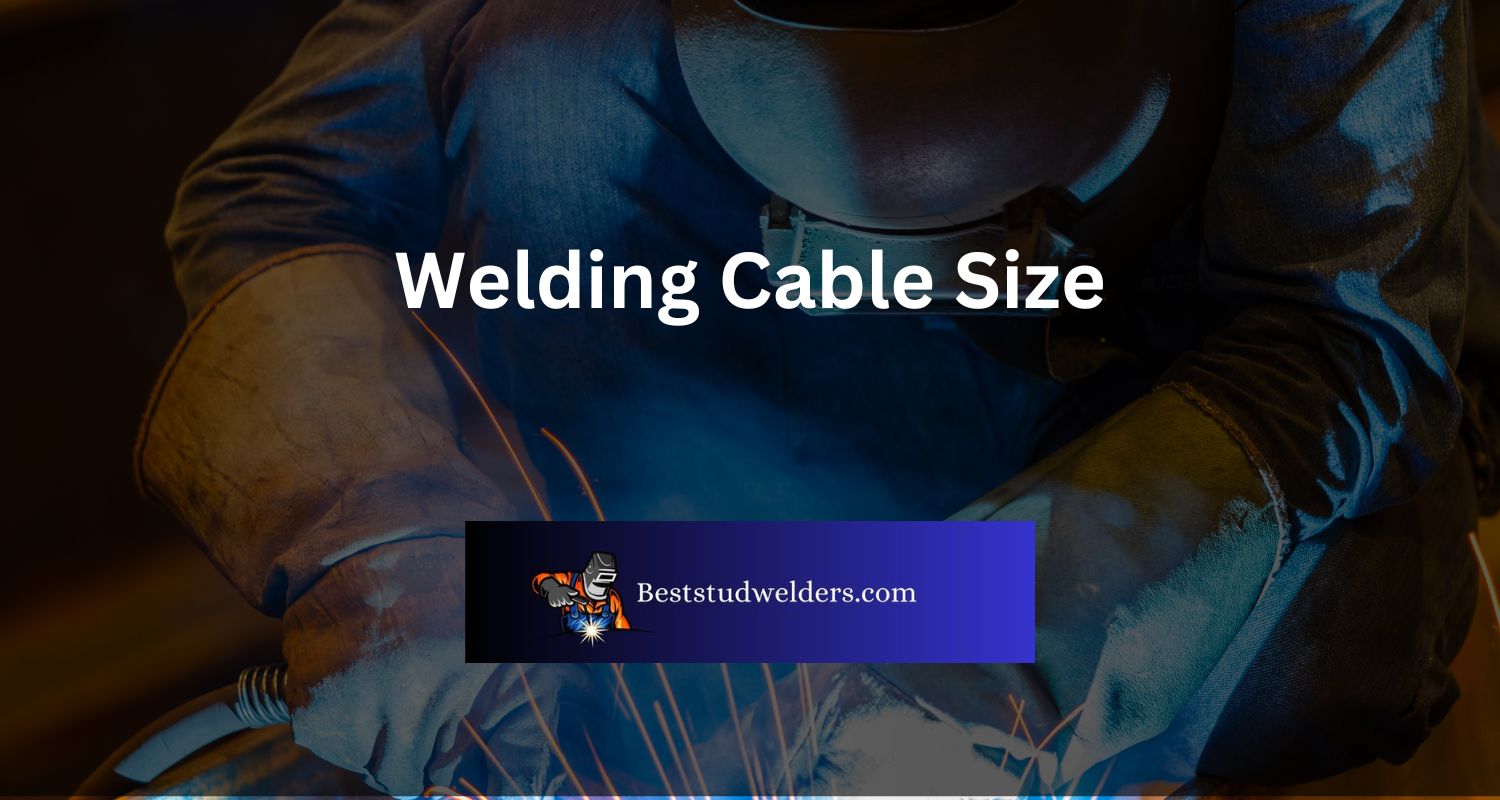Do you need an extra bit of strength and durability when it comes to your electrical cables? If so, welding cable is the perfect choice.
It’s made from industrial grade materials that are designed to last for decades, making it ideal for any job where power needs to be transmitted safely and securely.
But what size should you use? This blog post will explore the range of possibilities that welding cable provides and help you determine which size would best suit your particular project.
Read on to get a better understanding of why certain sizes work better than others!
Determining the Appropriate Welding Cable Size
To determine the appropriate welding cable size for your welding projects, you need to take into account various factors. Calculating the amperage requirement is necessary to avoid any electrical hazards. Different types of welding cables are available in the market, each with its unique features. Understanding the welding cable size chart helps in choosing the right size. Let’s explore these factors in detail.
Factors to Consider When Choosing Welding Cable Size
Selecting the right Welding Cable Size is really important for successful welding projects. There are a few factors to consider, like welding current, distance from power source, duty cycle and cable length. Let’s look into these more! Also, environmental conditions such as temperature and humidity must be taken into account. The wrong size cable can lead to voltage drop or overheating.
I once saw an apprentice select an undersized cable when doing maintenance on heavy equipment. With prolonged use and exposure to weather, the wire became weak, leading to insufficient current flow and increased resistance. This caused cable failure, hazardous conditions and delayed project completion.
Want to avoid a shocking experience? Get your amperage calculations right when selecting the perfect welding cable size.
Calculating the Amperage Requirement for Welding Cable Size
To find the right size welding cable, it’s vital to calculate the amperage needed. This can lead to good welding and avoid electrical danger. A table will help you, considering factors like distance to power source, duty cycle, and ambient temperature. It should show cable length in feet, minimum wire gauge number, and max amperage capacity. This helps welders pick the best cable.
Be aware – cable size could differ depending on welding process (e.g., TIG or MIG). These need particular amperage levels. Make sure you pick the right size cable to stop electric accidents. Use this info when selecting cable for your job – it’ll help keep safety standards up while you weld. Get ready to be wired for success!
Types of Welding Cables Available in the Market
Different types of welding cables can be found in the market. They vary in terms of insulation, conductor size/material and voltage ratings. These include:
| Insulation Types | PVC, EPDM Rubber, Neoprene Rubber |
| Conductor Materials | Copper, Aluminium, Silver-Plated Copper |
| Conductor Sizes (AWG) | 6-4/0 (Flexible Conductor), 2-4/0 (Extra Flexible Conductor) |
| Voltage Ratings (V) | 600, 1000, 2000 |
When selecting a welding cable, flexibility is an important factor. This depends on the insulation material’s rigidity and conductor size. Additionally, some cables are resistant to wear & tear or environmental factors.
Here are tips for getting the right welding cable for your needs:
- Determine which type works best with your power source, based on factory recommendations.
- Choose a gauge large enough for the amperage needed to prevent excessive heat build.
- Use cables with suitable jackets for their intended environment, e.g. water-resistant ones near moisture sources.
- Check cables for any damage or signs of wear before each use.
- Get the perfect welding cable size for your needs by understanding the chart.
Understanding the Welding Cable Size Chart
When deciding the right cable size for welding, it can be overwhelming. But, you can easily find the right one by understanding the welding wire gauge chart. It gives info on how much current each wire size can handle without melting.
The wire gauge is the inverse of its size. When the value rises, the thickness drops. So, when welding thicker metals that need higher amperage, use a shorter, thicker cable to stop voltage drops.
Last August, welders working on an oil refinery plant in Texas used an undersized cable, causing power supply disruption. This doubled their workload and could have caused refinery problems.
Knowing the welding cable size chart is essential for a smooth welding process and avoiding delays like these. Choose the wrong one and you’ll get an unpleasant shock.

Importance of Selecting the Right Welding Cable Size
To ensure safety during welding operations and to prevent voltage drop and power loss, selecting the right welding cable size is imperative. The importance of selecting the right welding cable size lies in ensuring that the electrical current can be transmitted effectively and efficiently through the welding cable, which can then be used to produce high-quality welding.
Ensuring Safety during Welding Operations
Welders’ wellbeing is key. Secure working conditions are paramount when welding. Necessary safety measures must be taken, to avoid accidents.
Matching a welding cable to the equipment is vital. This affects safety, productivity and sound quality, during welding operations. Wire thickness is proportional to current capacity. This limits power loss, overheating and short circuits.
Welding burns are all too common. Statistics show 500,000 people injured by welding each year.
Choosing the right cable size can reduce fatalities and bodily harm. This is due to voltage drops, sparking hazards from worn-out wires.
Prevent power loss and voltage drops, with the correct cable size. Nobody wants weak welds, or risks!
Preventing Voltage Drop and Power Loss
To avoid power loss, welding cable size matters. Here’s a guide in 4 steps to choosing the right one:
- Calculate the amperage of your welder.
- Figure out the distance between welder and workpiece.
- Pick a cable that can handle the expected amperage at that distance.
- Check connections are secure and free from damage.
Thin cables have more resistance and generate more heat. So, choose a cable size that matches the job and environment.
Did you know an explosion occurred at a chemical plant due to wrong cable selection? The fire caused serious damage nearby and put lives at risk. So, follow guidelines when sizing cables, particularly in hazardous industries.
Avoid disasters with the wrong choice – follow these tips for selecting welding cable size.
.jpg)
Common Mistakes to Avoid When Choosing Welding Cable Size
To avoid common mistakes when selecting welding cable size with its sub-sections of overestimating or underestimating the amperage requirement, ignoring the distance between welding machine and workpiece, and compromising on cable quality to save costs, it’s important to understand the impact of each factor.
Overestimating or Underestimating the Amperage Requirement
Choosing the wrong amperage for welding can be hazardous. People often make mistakes like either overestimating or underestimating the amperage requirement. This can lead to problems like electric shock, and cable health deterioration.
To gain better understanding, take a look at the table below. It shows different cable sizes and their ampacity ratings.
| Cable Size | Ampacity Rating |
| 2/0 | 200 amps |
| 3/0 | 250 amps |
| 4/0 | 300 amps |
It is essential to select the correct ampacity rating for your application. Don’t go overboard when making a choice. This could damage the solutions being operated by the cables.
In some industrial plants, choosing the wrong amperage has caused major accidents. For example, an operator received severe burns when welding metal objects with high ampere requirements. He was hospitalized for weeks before he healed.
Don’t forget the gap between your machine and workpiece while welding! Otherwise, you might get a literal shock!
Ignoring the Distance between Welding Machine and Workpiece
When choosing cable size for welding, it’s important to take distance into account. Too thin wires can lead to voltage drops and bad welds plus inefficient operations. Calculating the distance and workspace size is key to selecting the right cable.
Go for the proper gauge for optimal performance. Or, use an online calculator or ask a professional electrician for help. Don’t cut corners – you’ll pay for it eventually!
Compromising on Cable Quality to Save Costs
Don’t be tempted by low-priced welding cables – it’s a false economy! Inferior-quality can cause overheating, electrical failures or even fires. So, it’s wise to opt for the better quality ones that meet the necessary standards.
High-quality cables offer better conductivity, increased flexibility and smoother welds. Invest in them and you’ll be welding safely and efficiently.
Remember – size matters! Choose wisely and weld safely.
Conclusion
Choosing the right size of welding cable is critical for safe and efficient welding operations. Wrong sizes can lead to power loss, overheating, and damage to the equipment and environment. It is important to pick an ideal welding cable size that meets the welding needs.
To help you make a wise decision, here’s a table showing the recommended welding cable size for different amperage ratings. It has the standard American Wire Gauge (AWG) size, application range in Amps, and maximum duty cycle percentage for dependable performance.
| AWG Size | Amp Range | Max Duty Cycle Percentage |
|---|---|---|
| 6 | 75-100 | 20% |
| 4 | 100-150 | 30% |
| 2 | 150-200 | 40% |
| 1/0 | 200-250 | 35% |
| 2/0 | 250-300 | 50% |
| 3/0 or 4/0 | Over 300 amps. | 60% |
In addition to the table, other factors like cable length and voltage drop must also be considered when selecting the best cable size.
It’s important to remember that getting a higher capacity cable than needed can make it hard to access, and can increase your system’s cost. So don’t only rely on under-sizing methods. Therefore, understanding electrical load bonds will help when choosing a suitable Welding Cable Size – ensuring safety measures are in place.
This knowledge of selecting Welding Cable Sizes dates back to the Industrial Revolution. Experts back then knew how cables were affected by various parameters. Today with advances in technology and global research, these recommendations act as guidelines for efficient operation times with improved safety compared to previous centuries.
We hope these guidelines help you make informed decisions when selecting appropriate Welding Cable Sizes with a professional point of view.
Frequently Asked Questions
What determines the best size for welding cable?
The amperage and length of the cable needed for the welding task determine the best size for welding cable.
What is the most commonly used welding cable size?
The most commonly used welding cable size is 2/0, which can handle up to 200 amps.
Can I use a smaller cable size than recommended for my welding job?
It is not recommended to use a smaller cable size than recommended as it can result in inadequate power supply, causing poor quality welds and damage to the welding machine.
Can I use a larger cable size than recommended for my welding job?
It is possible to use a larger cable size than recommended, but it can be costly and impractical. It is best to consult with a professional to determine the appropriate size for your welding job.
Does the material of the cable affect its performance?
Yes, the material of the cable affects its performance. Copper cables are the most commonly used due to their high conductivity and durability.
What is the standard color coding for welding cable sizes?
The standard color coding for welding cable sizes is black for negative and red for positive cables.
Paul Dixon is a certified welder with a wealth of experience in welding and related technologies. He started his career as an apprenticeship in welding, where he learned the ropes and acquired extensive skills in the craft.
Over the years, Paul has continued to sharpen his expertise, earning him top-rated welding certification. He remains one of the most outstanding welders in the industry.







